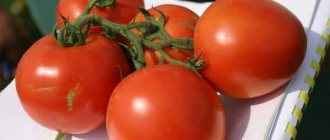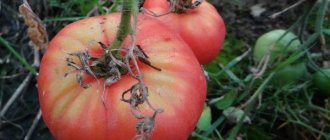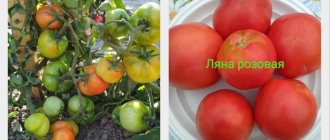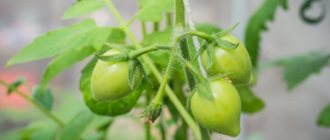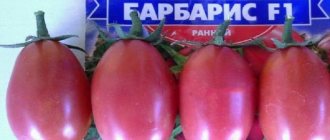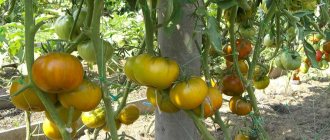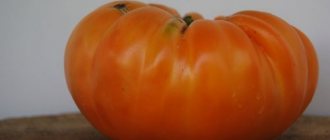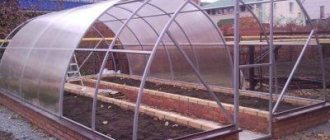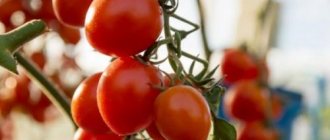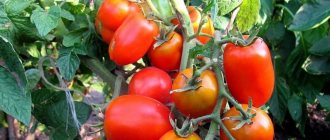Hybrids of Dutch tomatoes have found recognition in many countries around the world. Not the last place among early-ripening tomatoes is occupied by the Ivanhoe f1 hybrid.
| Height | Landing location | Ripening time | Fruit color | Fruit size | Origin | Fruit shape |
| Medium height | Greenhouse | Early ripening | Reds | Large | Hybrid | Plum-shaped or oval |
Tomato "Ivanhoe F1": description of the variety
| Variety name | Ivanhoe F1 |
| general description | Early maturing, indeterminate high-yielding hybrid |
| Originator | Holland |
| Ripening period | 115-120 days |
| Form | Round, slightly elongated, with slight ribbing at the stalk |
| Color | The color of ripe fruits is red |
| Average weight of tomatoes | 170-180 grams |
| Application | Universal |
| Productivity of the variety | 8-10 kg per square meter |
| Features of cultivation | Preferably grown by seedlings |
| Disease resistance | Well resistant to major diseases of tomatoes in greenhouses |
Tomato "Ivanhoe" F1 is an early-ripening, high-yielding hybrid of the first generation.
The bush is indeterminate, tall, moderately spreading. You can learn about determinate plants here. The stem is strong, the root system is well developed. The formation of green mass is average, the leaves are medium-sized, simple, dark green. The fruits ripen in clusters of 6-8 pieces. Productivity is good, from 1 sq. m of planting, you can remove 8-10 kg of selected tomatoes.
| Variety name | Productivity |
| Ivanhoe | 8-10 kg per square meter |
| Solerosso | 8 kg per square meter |
| Soyuz 8 | 15-19 kg per square meter |
| Aurora f1 | 13-16 kg per square meter |
| Red Dome | 17 kg per square meter |
| Aphrodite | 5-6 kg per bush |
| King of the Early | 12-15 kg per square meter |
| Severenok f1 | 3.5-4 kg per bush |
| Ob domes | 4-6 kg per bush |
| Katyusha | 17-20 kg per square meter |
| Pink fleshy | 5-6 kg per square meter |
Basic information about tomatoes
The Ivanhoe f1 hybrid was bred for film greenhouses and greenhouses. Characteristics and external description of the variety:
- Early ripening, the ripening time of tomatoes is 3 months;
- Indeterminate;
- Tall, up to two meters in height;
- Moderately spreading;
- Medium foliage;
- Small leaves, light green in color;
- Developed root system;
- Powerful stems;
- High yield, up to 10 kilograms of berries are harvested per square meter of planting;
- Harmonious ripening of fruits;
- Resistant to most nightshade diseases;
- Unpretentiousness;
- Good keeping quality;
- Transportation over long distances is possible without loss of presentation.
Positive reviews from gardeners about the Ivanhoe tomato indicate the positive qualities of the fruit. The berries of this variety are different:
- Round shape;
- Medium size, with a maximum weight of up to 180 grams;
- Slight ribbing;
- Medium density;
- Bright red color, without inclusions when ripe;
- Multi-chamber;
- Juicy;
- Sweet taste, with slight sourness;
- Fragrant.
Thanks to its good transportability, the tomato is convenient for growing on an industrial scale and on farms. The berry is suitable for pickling and canning. The versatility of the variety allows the fruit to be processed into tomato products and consumed fresh.
Origin and application
The Ivanhoe tomato variety was bred by Dutch breeders. Designed for growing in glass greenhouses and film greenhouses. The collected fruits are well stored and can be transported. The variety is ideal for sale, so it is often grown on farms.
The fruits are universally used, they are delicious fresh, suitable for preparing salads, sauces, and soups. Ripe tomatoes produce juice with a refreshing sweetish taste.
Growing tomatoes
The Ivanhoe F1 hybrid is unpretentious and does not require special care. It is preferable to grow tomatoes in seedlings.
How to prepare seeds?
The main condition for preparing seeds is the selection of dense and whole seeds. Before sale, planting material is treated with a special fungicide Tiran. Therefore, there is no need to soak the seeds in a solution of manganese or boric acid for disinfection.
Sowing seed material
Seeds are usually sown in pre-prepared containers with soil 60-65 days before the seedlings are supposed to be planted in the ground. It is possible to sow seeds in peat pots - in this case, the seedlings do not need picking.
After the first shoots appear, the temperature in the room where the containers are located should be about 20 °C. The bushes should be regularly irrigated with warm water using a spray bottle.
Rules for planting seedlings
Young plants need organic and mineral fertilizing, which is carried out twice a season.
Advantages and disadvantages
Among the main advantages of the variety:
- early amicable maturation;
- high taste qualities of fruits;
- unpretentiousness;
- does not suffer from sunburn;
- resistance to major diseases.
The variety has practically no disadvantages. The only difficulty can be considered the need to form a bush.
Bush care
When the bushes become tall, they need shaping. It is advisable to grow plants in 1 or 2 stems. Stepchildren are usually removed after 1-2 brushes.
In order for more oxygen to reach the tomatoes, it is recommended to remove the lower leaves.
Since the bushes are not susceptible to sunburn, they should not be shaded. It is recommended to water the plants with settled warm water at least once a week. Tomatoes of the “Ivanhoe” F1 variety must be fed 3-4 times per season with mineral fertilizers containing nitrogen and phosphorus.
Features of cultivation
The Ivanhoe tomato variety is preferably grown in seedlings. The seeds do not need to be disinfected or soaked; they undergo special treatment with growth stimulants before sale. Soil for seedlings is made from a mixture of garden soil with humus or peat. Seeds are sown in containers or peat pots; the latter method eliminates picking.
Attention! Germination requires a temperature of about 25 degrees. After emergence of seedlings, it is reduced; the plants are regularly sprayed with warm water from a spray bottle.
When real leaves appear on the seedlings, picking is carried out. Young tomatoes are fed twice with liquid complex fertilizer. Read more about fertilizing tomatoes when picking here. A week before transplanting, it is recommended to harden the seedlings by placing them in fresh air.
Moving seedlings to a greenhouse or greenhouse begins in the second half of May. Tomatoes should have 6-7 true leaves and at least one developing flower raceme.
Before planting, the soil is fertilized with humus, and wood ash is laid out in the holes (1 tablespoon per plant). A distance of 40 to 50 cm is left between the bushes; thickening of plantings negatively affects the yield. Tall bushes need shaping. It is advisable to plant them in 1-2 stems, removing the shoots after 1-2 clusters. To allow sun and air access to the fruits, it is recommended to remove the lower leaves.
Plants are not afraid of sunburn, so there is no need to shade them. Watering is moderate, with warm, settled water. During the season, tomatoes are fed 3-4 times with mineral fertilizer based on phosphorus or nitrogen.
Recommendations for cultivation
For the variety, the seedling planting method is preferred. Work begins at the end of March. To grow healthy seedlings you need:
- Prepare containers with universal soil for tomatoes;
- Planting seeds to a depth of 1-2 centimeters;
- Cover the containers with film until sprouts appear;
- Ensure the temperature in the room is from + 22 degrees;
- Regular watering with settled water, spraying with a spray bottle;
- Tying to a support;
- Place the seedlings in a well-lit place.
See also
Characteristics, description and features of growing Octopus tomatoRead
IMPORTANT! When the first permanent leaves appear, pick the tomato.
The plant loves space; it is recommended to plant no more than 4 bushes per 1 square meter of land. The unpretentiousness of the variety made it possible to obtain a good harvest even in the absence of serious experience in growing tomatoes. Mandatory care measures include:
- Loosening the soil;
- Water the tomato with warm water as needed;
- Feeding with complex mineral fertilizers 3 to 6 times during the growing season;
- Weeding the earth.
Diseases and pests
Like other hybrids, "Ivanhoe" is protected from typical nightshade diseases. It practically does not suffer from tobacco mosaic, fungus, nematode or fusarium wilt; early ripening protects tomatoes from late blight. For greater safety, the soil is treated with a solution of potassium permanganate or copper sulfate before planting. Plants are sprayed with phytosporin or other non-toxic biological product.
During the flowering period, young tomatoes are affected by spider mites and thrips. Spraying with a weak solution of potassium permanganate helps; in severe cases, industrial insecticides are used. Aphids are destroyed with warm soapy water. Naked slugs are removed by hand, and then the plants are sprayed with an aqueous solution of ammonia. Read more about the fight against these pests in this material.
The Ivanhoe tomato variety is ideal for gardeners with greenhouses or greenhouses. Early ripening allows you to get tomatoes at the beginning of summer; the plants do not get sick and are little affected by pests.
High-yielding tomato varieties for greenhouses: overview of groups, hybrids and cultivation features
Of the wide variety of tomato varieties offered to farmers and amateur vegetable growers, it is impossible to unambiguously recommend only some and ignore others, because the preferences of a particular person are subjective. And this is understandable: each of us has our own criteria for evaluating the tomatoes we grow, but everyone always chooses the most productive tomatoes for greenhouses.
We are attracted by both the numerous number of fruits and the duration of fruiting of one bush.
In areas with different climates, the conditions for cultivating tomatoes (even in farm greenhouses) are different, so the most popular are specific, zoned varieties, which enjoy well-deserved attention from most gardeners.
The main difference between high-yielding varieties
Plants are indeterminate and determinate.
- Indeterminate varieties are ideal for greenhouses - vigorous bushes form into one stem.
- Determinate tomatoes for greenhouses require constant pruning of shoots.
Forming the stems
Each hybrid is prone to one of these 2 types of development, so we need to correct plant growth in time, starting right from the seedlings.
According to the type of growth, tomatoes are divided into 2 groups:
- with vegetative
- with generative development.
As a rule, well-known seed manufacturing companies provide the following starting information on the packaging: the main characteristics and individual characteristics of a particular variety.
- For low greenhouses for tomatoes with a standard (up to 2.5 m) ridge height, we will choose tall varieties of tomatoes with shortened internodes, and we will form them into 2 stems. When the bushes grow to the trellis, each shoot will already have 3 brushes. We will release additional shoots from the seedlings under the very first cluster.
- Typically, tall and large-fruited tomatoes exhibit a vegetative type of growth. We plant seedlings of hybrids and varieties with this vegetative type of development with the first two racemes flowering in order to prevent fattening of the plants, which reduces the yield of tomatoes in the greenhouse.
Review of varieties for greenhouse use only
Medium and tall productive varieties
The hybrid is resistant to fusarium, tobacco mosaic, cladosporiosis, and the yield of 1 plant is up to 5 kg.
- Intuition F1 - with 1 stem and unlimited growth, a mid-season hybrid of truss tomatoes: only 110 days pass from the first shoots to fruiting. Round, smooth fruits weighing over 100 g do not crumble even after ripening, do not crack, and their high sugar content is ideal for canning and fresh salads.
- Kostroma F1 is a two-meter mid-early hybrid; already 106 years after germination we harvest a healthy and abundant harvest of flat-round fruits weighing 150 g, and up to 5 kg per bush. This plant is resistant to viruses and changes in humidity and temperature.
- Rosemary F1: 115 days after sprouting, large (400g), pink, smooth fruits ripen for delicious salads. Their flesh is juicy, tender, and has a “melting” consistency. Productivity reaches 11 kg per plant.
- Chio-chio-san is a mid-season hybrid with unlimited growth, hung with huge branched clusters, with 50 fruits on each. Pink, plum-shaped tomatoes weighing up to 40 g delight us with an excellent dessert taste and four kilograms of such fruits per bush. The variety is not susceptible to tobacco mosaic disease.
This hybrid is resistant to viruses.
- Blagovest F1 is a one and a half meter tall, early ripening, hundred-day hybrid. One plant produces 5 kg of round fruits weighing over 100 g each.
- Verlioka F1 is a one and a half meter tall, early ripening plant with round fruits up to 100 g each and 5 kg per bush. This tomato is great for canning and fresh salads.
As the personal experience of gardeners proves, the most productive varieties of tomatoes for a greenhouse are numerous: their list can include dozens of other hybrids and varieties of tomatoes, even for one region.
Interesting new varieties
The average size of a Siberian fruit is 1.5 kg.
- Siberian F1 is a late-ripening, single-stem hybrid with unlimited growth that produces a yield of up to 5 kg in 4.5 months. Its flat-round, smooth, aromatic tomatoes are unique in size - up to 2.8 kg, and their taste is harmonious, dessert. The plant is not susceptible to diseases such as cladosporiosis and fusarium.
- Ural F1: This indeterminate tomato with unlimited growth for the Ural region will produce the first tasty, sweet tomatoes for salads in just 4 months. Up to 25 flat-round fruits weighing 350 g grow on 1 bush.
- Shaolin F1 is a plant with a medium ripening period: after 115 days, the first large (up to 400 g), pink, beautiful tomatoes, intended for salad purposes, ripen on powerful low bushes. Their pulp is tender, juicy, as if melting, with an abundance of provitamin A. The average yield is 10 kg per plant.
The yield of these tomatoes is 7 kg per bush.
- Kamchatka F1 is a one and a half meter mid-season (110 days before fruiting) variety with attractive and tasty round fruits weighing up to 150 g, stored for up to 2 months. The hybrid is resistant to all viral pathogens dangerous to these plants.
All of these listed productive varieties of tomatoes for greenhouses have already been appreciated by experienced vegetable growers and are leaders in the sale of seeds, especially since they are not very demanding on care.
Greenhouse tomato plants
We collect their fruits with tassels, like grapes in clusters.
This type is gaining well-deserved popularity. Breeders have successfully bred the following hybrids: Fatalist, Fan, Vladimir and others.
Peculiarities:
- A valuable feature of this type is its high strength: we can transport the crop anywhere, but the tomatoes do not spoil or crack.
- The fruits on the cluster are often the same size: 100 – 200 g.
- Such greenhouse tomatoes are absolutely resistant to diseases characteristic of these plants, so we do not have to spend money on purchasing various preventive chemicals.
Most Popular
Of course, it is almost impossible to list all the high-yielding tomato varieties for greenhouses - after all, breeders delight us with their new achievements. Among them, De Barao red and Hybrid Ivanhoe F1 stand out. It is believed that these varieties in a greenhouse produce over 20 kg of fruit from 1 bush.
De Barao
For De Barao, the norm is 30 kg per plant, and the record is 70 kg.
- Even in open ground, this variety under normal conditions and proper care produces 10 kilograms per bush.
- Its smooth fruits are of medium size with a weight of 150 g and are very tasty fresh or canned.
- However, the hybrid is very demanding on the microclimate and grows poorly on infertile, heavy clay or loamy soils.
- Breeders have pleased gardeners with original early varieties of tomatoes for greenhouses, which are not inferior in yield. But they have a different color, indicated in their very name: De Barao yellow, pink or black.
In the photo - Black cream De Barao
Semko-Sinbad F1
One of the most popular early ripening hybrids was Semko-Sinbad F1.
- In terms of early maturity, it is not inferior to the Hurricane variety, in which the first tomatoes turn red already on the 80th day after the seedlings peck.
- Ovaries on the plant also form without additional measures.
- Its inflorescence contains 8 red fruits weighing up to 100 g with an average yield of about 10 kg per 1 sq. m.
Hybrid Ivanhoe F1
The new salad tomato surprises with its yield: the fruit on its clusters is like a well-groomed bunch of grapes.
- All tomatoes are bright red and do not shrink closer to the top of the bush, ensuring excellent harvesting without the use of growth stimulants.
- The taste of the fruits of this hybrid is much better than other greenhouse counterparts, and the bush itself is large, with powerful thick stems.
- Ivanhoe, with its high yield, practically does not get sick and is resistant to fungi, tomato mosaic, nematode, and verticillium.
- It is especially valuable for lovers of natural farming: it gives an excellent harvest without the use of chemicals.
- But this variety actually has no disadvantages, only the price of its seeds is higher. And we won’t put tomatoes in regular jars - they are very large.
Alhambra
- Its excellent yield is successfully combined with another advantage - the brushes do not refract.
- The taste of tomatoes is excellent.
- This variety bears maximum fruit in greenhouses from April to January, forming ten-meter vines.
Caring for high-yielding tomatoes
We monitor the load of plants directly with fruits and adjust it in a timely manner, taking into account the characteristics of the variety.
Top dressing
- It is advisable to carry out agrotechnical regulation of the development of bushes only if they have a balanced mineral nutrition.
Note! Experience shows that it is better to limit nitrogen before the formation of the first bunch of fruit, especially in plants with vegetative development.
- During the growing season, we regularly apply, as the instructions recommend, phosphorus-potassium fertilizers, during flowering and a little later - phosphorus fertilizers, and for fruit growth - potassium and nitrogen fertilizers.
- 1 week before planting the seedlings in the garden greenhouse, stop feeding them, and after planting, we will do the first feeding 2 weeks later.
- In case of excessive vegetation, we apply foliar feeding on the leaves - an extract from superphosphate, as well as root phosphorus-potassium fertilizer.
- With accelerated generative development, we will do 2 feedings with fermented weeds - this will speed up the ripening of unexpectedly numerous fruits in cool weather.
- The seedlings need very loose soil, so add 30% peat to the black soil. But a mixture with vermicompost and perlite is ideal for this: we pour it, compacting it, into boxes and water it, as a result it will sag. Here we sow 1 seed every 5 cm (depth - 1.5 cm) .
Seedling care
- The shoots will appear in a week, and we will lower the temperature to +18C .
- Water with warm, settled water once every 3 days.
- To rid the sprouts of root rot, we use biological products.
- When a true leaf appears, place the seedlings one at a time in plastic or peat pots.
Plant care
- We place the seedlings in a row on the ground every 50 centimeters, and 60 cm .
Note! We place seedlings of large-fruited tomatoes in heated shelters 50 days after germination, and in unheated shelters in May.
- Add 1 tablespoon of calcium nitrate or 2 cups of humus into the hole.
- We tie up the overgrown bushes with a trellis, thrown over a 5 mm wire stretched along the rows.
- Next, we simply twist the trellis with our own hands as the bush grows, water it, and after flowering, feed it with ready-made balanced organic matter 2 times a month.
- We will tie up large-fruited tomatoes - these high-yielding varieties need such support.
- We regularly remove shoots from the leaf axil.
We collect fruits that are brown, since their complete redness depletes the plant.
Conclusion
Experienced gardeners experiment with several varieties of tomatoes at once, because a specific soil and region have their own productive hybrids.
- When choosing varieties, we take into account the characteristics of the greenhouse and growing conditions.
- Traditional and proven greenhouse tomatoes are good, but new varieties are more hardy and productive with easy care.
- We buy large packages of the selected variety and plant 50 seeds; if the result is successful, we sow the remaining seeds.
We are guaranteed to get a wonderful harvest of organic tomatoes in a garden bed in a greenhouse by observing simple conditions:
- we feed the seedlings;
- we fertilize the sprouts already planted in the ground;
- we plant the stems;
- protect against late blight.
The video in this article has more information about high-yielding tomato varieties.
oteplicah.com
Description and characteristics
The Ivanhoe tomato variety is designed for cultivation in greenhouse conditions and is a first-generation hybrid. Refers to early ripening plants. You can harvest the crop already 90 days after the formation of the bushes.
The bush grows up to one and a half meters in height. It has a well-developed root system and a fairly dense and strong stem. Greening is average.
The fruits of "Ivanhoe" have cluster ripening. There are up to 8 fruits per cluster. The weight of one is up to 200 grams. Tomatoes have a round, oblong shape, with slight ribbing at the stalk. The color of ripe fruits is bright red and has no other colors or spots. The pulp is quite dense and juicy. When the fruits ripen, it seems that there are as many tomatoes on the bunch as there are grapes on the bunch.
As for the taste, it cannot be called watery; it is quite sweet and has “sour” notes.
High yield. 1 plant bush accounts for up to 10 kilograms. The fruits do not crack and can easily be transported.
It is still used all over the world for home use (for salads and canning) and on farms (for large-scale cultivation for sale).
Advantages and disadvantages
The Dutch hybrid "Ivanhoe" has a number of advantages:
- ripens early and simultaneously. You can enjoy ripe fruits already at the beginning of summer;
- has high taste qualities. Suitable for consumption both fresh and canned;
- easy to care for;
- does not have a tendency to form sunburn;
- resistant to many diseases.
In addition to the vast number of advantages, there are also disadvantages. There are only two of them and they are not significant:
- the need to form a bush;
- The fruits are so large that it is impossible to pickle them whole.
Reviews
Margarita
For a very long time I could not decide on the choice of greenhouse variety. Everything is wrong for me and in the wrong place. Either the care is too difficult, or the planting is too difficult, or the soil is not needed. In general, magpies are terrifying. Upset. And the neighbor bought Ivanhoe. I read about it for a long time and decided to try it myself. I can say one thing: the yield is completely bought at a high price. There were no problems during cultivation.
I've been growing this variety for a long time. I really like its taste. Let me tell you one trick, so as not to tie up or connect the bushes: stretch a wire along the row and tie the tomatoes to it. This way there is less hassle and they do not bend at all under the weight of the fruit.
Read also: Is it possible to eat sauerkraut during pregnancy?
We have been growing it for sale for about 5 years now. The variety is very resistant to everything. The important thing is that even under direct light nothing happens to him, and if my father leaves for a week, then I don’t need to do anything. Go and water it sometimes. As for the harvest, it is huge even without chemicals, but imagine what if you add fertilizers to stimulate growth? So I say that a homemade product is a natural product. For those who want to grow on large plantations, transportation cannot be a problem (unless, of course, they cannot get enough sleep). Otherwise, transportation is well tolerated.
The Dutch hybrid tomato Ivanhoe enjoys deserved popularity among Russian gardeners. This variety has a lot of positive characteristics that are appreciated by both farmers and consumers of finished products. The tomato is recommended for growing in film greenhouses and greenhouses covered with glass or polycarbonate. It is worth knowing about the features of the Ivanhoe variety, its advantages and disadvantages.
Grandmother's Pride - variety of Tomato plant
Information on admission of Tomato Babushkina Pride from the Register of the State Variety Commission of the Russian Federation
Application for admission No. 54889, registered 2010-11-09. The Tomato variety Babushkina Pride was included in the register of those approved in 2011. Approved for use in regions: All regions.
The originator of the Tomato variety Babushkina Pride is:
Information about the patent for the Tomato variety Babushkina Pride
Patent holder of the Babushkina Pride variety:
IP KUDRYAVTSEVA ELIZAVETA ROMANOVNA
Application for protection of the Babushkina Pride variety No. 54890, registered 2010-11-09.
Patent No. 6201, registered 2011-11-23. Estimated patent expiration date 2041-12-31.
- Myazina Lyubov Anatolevna
- Kudryavtseva Elizaveta Romanovna
Other varieties of tomato plant
Question to the portal experts
If you haven't found the answer to a question, don't hesitate to ask an expert.
Register or Login so you don't have to enter your Name and Email every time
Thanks for the comment! It will be published after checking by a moderator!
No comments yet, be the first!
A portal for those who love their dacha
Your question has been sent for moderation. Don't worry, we quickly check your questions and your question will be answered within 1 day.
We have noticed that you are already registered on our website. We recommend that you log in to view the created question.
If you don't remember your password, you can recover it.
You were not registered until today, so we have registered you. Your password has been sent to your specified mailbox.
Help our site develop!
Please read this message, it will not take up much of your time!
We so need your comments and questions to understand in which direction we should develop.
Don't forget to leave a comment if you found what you were looking for. And if you haven’t found it, use the “Ask an Expert” form in the site header. We will answer this question, and other visitors will be able to find the information that you could not find.
Your question has been sent for moderation. Don't worry, we quickly check your questions and your question will be answered within 1 day.
We have noticed that you are already registered on our website. We recommend that you log in to view the created question.
If you don't remember your password, you can recover it.
You were not registered until today, so we have registered you. Your password has been sent to your specified mailbox.
Ivanhoe pepper: description and characteristics of the variety, cultivation
Many people grow sweet peppers. This is not surprising, because they can decorate any table, benefit the human body, and can be canned or frozen. One of the best varieties is usually called Ivanhoe pepper. But how to get a good harvest by growing it?
Description of the variety
Ivanhoe pepper is part of the group of early sweet varieties. As soon as the shoots appear, no more than 115 days will pass before the first fruits begin to ripen. In appearance, this plant is quite compact; it does not grow tall.
The peppers themselves resemble a smooth cone. One fruit can weigh up to 140 g. When the peppers begin to ripen, they acquire a creamy hue. If they are fully ripe, then they turn reddish.
The pulp can reach a thickness of up to 7 mm.
Advantages and features of the variety
You can get the fruits of Ivanhoe pepper quite early, which is one of the advantages. In addition, they have an excellent presentation, so they are grown for further sale. It is interesting that you can eat yellow and fully matured fruits. From one hectare you can harvest up to 80 centners of crop.
Initially, seedlings are grown from seeds. When it has been growing for 65 days, then it is planted in open ground. With this method you can get the harvest very early. It is not prohibited to plant Ivanhoe pepper densely. The resulting fruits emit a pleasant smell and have an excellent taste.
The main advantage is that the Ivanhoe pepper crop tolerates storage and transportation well. This variety is not afraid of many diseases. But weather conditions can affect the plant. Therefore, it is recommended to grow such peppers in greenhouse conditions, this will allow you to get a lot of high-quality fruits.
Features of cultivation
Initially, it is worth deciding on the area where the crop will be grown. There should be no weeds on it. The area should be protected from gusts of wind, and the soil should be fertile. Peppers can be planted in the place where the following plants were grown:
- Cabbage
- Legumes and grains
- Onion
- cucumbers
But after nightshade crops you should not plant pepper. It is worth changing the planting location every year. Peppers can be planted in the same area after 3-4 years. This is done to prevent pests from accumulating in the soil. The soil must retain moisture. If it is loamy, then it must be supplemented with peat and manure.
If the selected area has clay soil, then the above components and sawdust, which are not completely rotted, as well as sand, are added to it. A garden with a lot of peat should be combined with humus.
It is worth remembering that peppers do not really like transplanting. Taking this into account, initially the seeds for seedlings should be planted in separate cups. In order for it to grow sufficiently, you need to wait 2 months in winter and 1.5 months in summer.
Initially, it is necessary to process the seeds.
For this, a solution of potassium permanganate is used, in which the seed material is placed for a third of an hour. After this, it should be washed well and sown in a prepared container. After 20 days, shoots will appear. They need to be thoroughly reconsidered.
Those sprouts that look strong should be moved to separate cups. When the seedlings have already grown up, and the weather is warm outside, you can start planting in open ground.
There should be about a quarter of a meter between each plant, and half a meter between each row. It is imperative to remember that hot peppers should not be grown near the Ivanhoe variety.
This is because improper pollination may occur.
As a result, the peppers will have a bitter taste. When plants are planted from pots, it is necessary to pay attention to ensure that the stem is immersed in the ground at the same level as it was in the previous container. It is recommended to plant seedlings in the evening. At the same time, do not forget about mulching and watering the holes.
To prevent the pepper from freezing, it is worth covering the bed with film material. The Ivanhoe variety needs careful care. To do this, the plant must be constantly watered, loosened the soil, and fertilized. It is also worth making sure that the soil is not too cold. There are certain rules for watering. The plant is watered at the following times:
- Every time after the harvest has been harvested
- During the landing period
- Every 10 days before the planned fruit harvest
- When 5 days pass after landing
Fertilizing is carried out for the first time when the temperature is around 20 degrees. To do this, you can use a special growth stimulator, for example, “Energen”. During the growing season, 4 loosenings are carried out. When the soil is loosened a second time, hilling is done. In this method, all weeds are destroyed, and the rhizome is enriched with air.
Use in cooking
Pepper is full of useful vitamins and microelements. It is especially rich in vitamin C. Scientists have proven that systematic consumption of this vegetable creates protection against the formation of cancerous tumors. Pepper improves the functioning of the stomach and other organs.
It is used in cooking. A variety of dishes are prepared from it. It can be processed in any way and can be combined with many other products. So, Ivanhoe pepper is an early variety that is grown by many owners. The main thing is not to forget about the rules of cultivation.
about planting and growing Ivanhoe pepper:
Source: https://ogorodsadovod.com/entry/2794-perets-aivengo-opisanie-i-osobennosti-sorta-vyrashchivanie
The best heart-shaped tomato varieties
In reviews of different varieties of heart-shaped tomatoes, the following characteristics are often found: bland taste, starchiness, unpleasant pulp consistency (like mashed potatoes), poor yield. However, reviews of gardeners from different regions about the same variety usually vary greatly. The taste, vigor of bush growth, and fertility depend on the climate zone, weather factors, growing conditions and quality of care. Among the heart-shaped tomatoes there are clear favorites, which give good results almost everywhere.
The best heart-shaped tomatoes
The first “heart” tomatoes were Pink and Red Bull's Heart; now the line of varieties has expanded significantly.
Thanks to the work of breeders, you can choose options based on fruit color, taste and other characteristics. Let us describe the heart-shaped tomatoes that have received the most positive reviews from gardeners from different regions. Most heart-shaped tomatoes have very fragile bushes and thin stems. Considering that the fruits are usually large, you cannot do without a high-quality garter. Indeterminate bushes should be grown in 2, maximum 3 stems. For convenience, we will divide the varieties according to the color of the tomatoes.
Pink varieties
They differ from others in that they have a delicate taste, a pleasant pulp consistency, thin skin, and contain an increased amount of dry matter, sugars, and antioxidants. Gardeners often praise tomatoes such as Yasha Yugoslavian, Sensei, Fatima, Minusinsk pink, Cardio, Kosovo, Japanese, Mikado Sibiriko, African Liana. We will describe the best varieties in more detail:
- Ukrainian Miracle of the Earth. Mid-early tomato for open beds and greenhouses. The bush is indeterminate. Immunity to disease is excellent; in rainy weather there is a risk of cracking. Tomatoes from 350 grams to a kilogram, the first ones are the largest, then gradually become smaller. The taste is good, sweet, absolutely no acid, aroma with fruity notes. Productivity is high.
- Russian beauty. Approved for cultivation in all regions in open and closed ground, as well as under film covers. It ripens in the middle period, the bush is indeterminate. Productivity up to 9 kg/m². The plant is resistant to fusarium and tobacco mosaic virus. The tomatoes are dense, slightly ribbed, weighing from 160 to 380 grams. The taste is sweet without acid.
- Dad. An early ripening, indeterminate variety for cultivation in greenhouses and greenhouses. Immunity to disease is excellent. Tomatoes from 150 to 450 grams, slightly ribbed, medium density, fleshy. The taste is excellent, there is no acid. Productivity up to 3 kg/m².
Red varieties
Traditional red tomatoes most often have a sour taste, weak or pronounced. They have less lycopene content than pink ones. To begin with, let's list the varieties and hybrids that 80% of summer residents like: Bulgarian and Belarusian Heart, Cone, Walford's Miracle, Andijan, Inseparable Hearts. Now let's move on to describing the best varieties:
- Vater Rein. Mid-season, semi-determinate (up to 1.5 meters) tomato for greenhouses. Tomatoes with an elongated nose weigh from 350 to 700 grams, sometimes up to a kilogram, fleshy, sweet, dense. Productivity is high, immunity to infections and pests is good.
- Budenovka. Designed for greenhouses, film shelters, planting in exhaust gas is possible only in the south. The ripening period is mid-early, the bush is indeterminate. The fruits are heavily ribbed, ranging from 150 to 400 grams. The taste is rich, balanced, pleasant. Productivity is about 9.5 kg/m².
- Kangaroo heart. Mid-season, indeterminate variety for open ground and greenhouses. The plant is unpretentious, resistant to negative weather factors, diseases, and pests. Productivity up to 14 kg/m². The tomatoes are fleshy, dense, have a dessert, sweetish taste.
Ivanhoe F1 (Ivanoye) is a natural product for tomatoes. early env. 170-180 gr. (Rijk Zwaan)
Order by phone
- +38 ( 050 ) 699-12-64
- +38 ( 066 ) 827-50-68
- +38 ( 066 ) 827-50-68
- +38 ( 067 ) 771-68-61
- +38 ( 068 ) 347-43-44
- +38 ( 097 ) 058-95-54
- +38 ( 093 ) 348-47-82
- +38 ( 063 ) 238-93-97
Order by phone
- +38 ( 050 ) 699-12-64
- +38 ( 066 ) 827-50-68
- +38 ( 066 ) 827-50-68
- +38 ( 067 ) 771-68-61
- +38 ( 068 ) 347-43-44
- +38 ( 097 ) 058-95-54
- +38 ( 093 ) 348-47-82
- +38 ( 063 ) 238-93-97
Regain respect
There is no minimum amount required! If you require an advance payment:
- for transactions up to 200 UAH;
- for goods subject to contract – 100% prepayment;
- a gift for every person.
Delivery methods
Skin day:
- Nova Poshta
- Ukrposhta
- Autolux
If the price is higher than 2,500 UAH and a vase up to 500 grams – delivery is free (from 12/15/2018)
Books
For a contract of 3,000 UAH – 3% reduction, 5,000 UAH – 5% reduction, 10,000 UAH – 10% reduction
Don't miss out on your books!
Receive gifts when you order online
Every buyer who has completed the order online (by registering in the store and making purchases through the box) takes away from the gift the magazine “Supermarket Nasinnya”, the packaging of the current calendar (included in the order from spring to the present day).
Contacts for completing an application at the ATO zone
We accept requests for vegetables from the ATO zone
Telephone: 066 061 04 03
Tomato Ivanhoe F1 description:
Tomato Ivanhoe is a high-yielding hybrid of indeterminate tomato.
The root is open, perfectly balanced, the nodes are in the middle, the root system is tight.
The fruits do not crumble and do not lose their sweetness and taste when grown in stressed minds. The fruits are thick, uniform, bright red in color, weighing 170-180 g.
Recommended for use in greenhouses with or without heating in spring, summer, and spring.
Resistant to cracking.
High resistance: HR ToMV / Fol: 0.2 / Va / Mi
To ensure high and stable yields, it is necessary to carefully select agrotechnical approaches, such as those aimed at growing tight, strong shoots, such as the proper shaping of the first fruits in a short time.
From new harvests to technical maturity of the fruits 105-115 days, to biological - 125-135 days.
Video about tomato Ivanhoe F1
What the original packaging looks like:
Tomato Ivanhoe F1 participant in the review of popular red indeterminate tomatoes for the Supermarket Magazine Nasinnya No. 4 “Autumn 2015 – Winter 2016”, page. eleven.
The Ivango F1 tomato (Rijk Zwaan) can be supplied in two types of packaging:
– original packaging (type of bottle)
– packaging for Nasinnya Supermarket.
If you require these products in original packaging, please indicate this in the comments before making an order, or tell the sales consultant when making an order by phone.
The manufacturer reserves the right to change the packaging design, color and appearance of processing.
Tomato Pineapple
Another representative of the American selection. It appeared in our country not so long ago, but has already become popular. A tall, early-ripening variety intended for cultivation in greenhouses.
It is recommended to form the bushes into three stems and tie them to a trellis. It has a long period of fruiting - until autumn with proper care. The shape of the tomatoes is flat-round. Their color is yellow-pink.
The pulp is dense, fleshy, the color is uneven. There are few seed chambers. Has a light citrus aroma. The taste is sweet, without acid. By the end of the season, the taste improves further.
5-6 large tomatoes are formed on one brush. Weight can reach 900 g, but specimens weighing 250 g are more common. They are not prone to cracking and almost never get sick. They tolerate transportation well. It has a universal culinary use - cut into salads, winter preparations and pasta.
